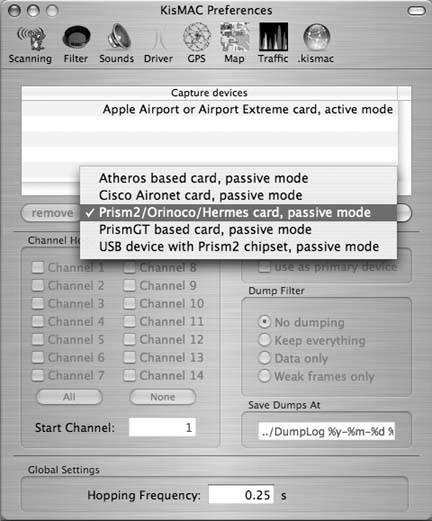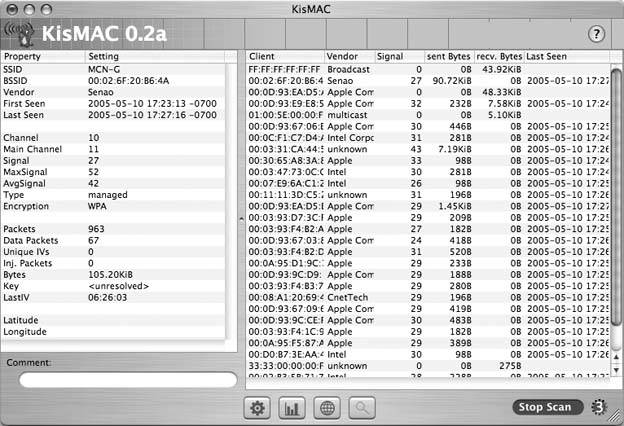Hack 28. Scan Passively with KisMAC


Glean detailed network information with KisMAC, a passive scanner for Mac OS X.
KisMAC (http://www.binaervarianz.de/projekte/programmieren/KisMAC) is a Mac OS X tool that shares part of its name with the popular monitoring tool Kismet [Hack #29]. This is a much more advanced network discovery and monitoring tool than either MacStumbler or iStumbler [Hack #27]. It requires Mac OS X 10.3 or above.
As covered in previous hacks, active scanners work by sending out probe requests to all available access points. Since these scanners rely on responses to active probing, it is possible for network administrators to detect the presence of tools such as MacStumbler and iStumbler, or any other tool that makes use of active network probes.
KisMAC is a passive network scanner. Rather than send out active probe requests, it instructs the wireless card to tune to a channel, listen for a short time, then tune to the next channel, listen for a while, and so on. In this way, it is possible not only to detect networks without announcing your presence, but also to find networks that don't respond to probe requestsnamely, closed networks (i.e., access points that have beaconing disabled). But that's not all. Passive monitors have access to every frame that the radio can hear while tuned to a particular channel. This means that you can detect not only access points, but also the wireless clients of those access points.
Newer Macs with Airport Extreme cards are a problem for KisMAC. The Airport Extreme is an 802.11g radio based on a chipset from Broadcom. Broadcom does not publish details on their chipsets, so it is impossible for open source projects to write supporting drivers. This is a bigger problem than just network monitors for Mac OS X. It affects anyone wanting to run Linux or BSD on laptops with Broadcom-based wireless hardware.
For older Macs with 802.11b AirPort cards, there is better news. The standard AirPort driver doesn't provide the facility for passive monitoring, but KisMAC uses the open source Viha AirPort driver (http://www.dopesquad.net/security). It swaps the Viha driver for your existing AirPort driver when the program starts and automatically reinstalls the standard driver on exit. To accomplish this driver switcheroo, you have to provide your administrative password when you start KisMAC.
|
KisMAC also supplies an alternate driver called MacJack for Orinoco/Avaya/Proxim cards, as well as Prism II-based wireless cards. Prism II-based USB dongles are particularly handy for passive scanning on a new Mac laptop. Support for Atheros and PrismGT 802.11a/b/g cards, as well Cisco 802. 11b equipment, is new to the latest R64 release of KisMAC for Mac OS X 10.4.
To use any of the non-Apple wireless hardware, you'll have to add support for the specific type of card in the KisMAC Preferences pane. Click on the Driver icon to bring up the screen shown in Figure 2-24. Select the type of card you need and click Add. You can set a number of options for each card, but for the purposes of this hack, just accept the defaults.
Once you've set any other options, close the Preferences pane and click Start Scan. If you have any of the cards loaded that require alternate drivers, you'll again be asked for your administrative password to load the required driver.
KisMAC's main screen provides much of the same information as MacStumbler or iStumbler: SSID, signal strength, and so on. Double-clicking any available network shows a wealth of new information, as shown in Figure 2-25.
Figure 2-24. Adding a network card type

One interesting side effect of passive scanning is that channel detection isn't 100 percent reliable. Since 802.11b channels overlap, it is sometimes difficult for a passive scanner to know for certain which channel an access point is tuned to, and it can be off by one from time to time.
Now, let's go back to the Options page. As shown in Figure 2-26, KisMAC allows you to specify which channels you would like to scan on. This can help if you are trying to find access points that are using the same channel as your own.
KisMAC has a slew of nifty features, including GPS support with user-defined maps, raw frame injection (for Prism II and Orinoco cards), and even a real-time relative traffic graph (Figure 2-27). If it detects a WEP network, it can use a number of advanced techniques to try to guess the password. And yes, it can read discovered ESSIDs aloud using Apple Text-to-Speech.
Figure 2-25. Detailed network information

Perhaps the most powerful feature of all is KisMAC's ability to log raw 802. 11 frames to a standard pcap dump. Check the Keep Everything or the Data Only option in the Driver tab of KisMAC Preferences to save a dump file that can be read by tools such as Ethereal [Hack #31].
KisMAC is probably the most advanced wireless network monitor available for Mac OS X, although it is still quite beta. Keep iStumbler handy, because it is more stable and can operate without mucking about with replacement drivers. If you are simply looking for available networks, KisMAC is probably overkill. Sometimes you need as much detail as you can get to troubleshoot difficult network problems, and when you do, KisMAC is the right tool for the job.
Bluetooth, Mobile Phones, and GPS
- Hacks 122: Introduction
- Hack 1. Set Up Bluetooth on Linux
- Hack 2. Set Up Bluetooth on Windows XP
- Hack 3. Connect Mac OS X with a Bluetooth Phone
- Hack 4. Connect Linux with a Bluetooth Phone
- Hack 5. Connect Windows XP with a Bluetooth Phone
- Hack 6. Use Your Treo as a Modem
- Hack 7. Send SMS from a PowerBook
- Hack 8. Remote Control Mac OS X with Bluetooth Phones and PDAs
- Hack 9. Remote Control Linux with a Bluetooth Phone
- Hack 10. Control XMMS with Bluetooth
- Hack 11. Liven Up Parties with a Participatory Slideshow
- Hack 12. Send SMS from Linux
- Hack 13. Remote Control Windows with Bluetooth Phones and PDAs
- Hack 14. Control Your Bluetooth Phone with FMA
- Hack 15. Control Your Computer from Your Palm
- Hack 16. Control Your Home Theater from Your Palm
- Hack 17. Choose a Cellular Data Plan
- Hack 18. Blog from Your Mobile Phone
- Hack 19. Get Google Maps on Your Mobile Phone
- Hack 20. Share Your GPS
- Hack 21. Broadcast Your GPS Position
- Hack 22. Map Wi-Fi Networks with Kismet and GPSd
Network Discovery and Monitoring
- Hacks 2339: Introduction
- Hack 23. Find All Available Wireless Networks
- Hack 24. Discover Networks with NetStumbler
- Hack 25. Detect Networks with Handheld PCs
- Hack 26. Find and Join Wireless Networks with AP Radar
- Hack 27. Detect Networks on Mac OS X
- Hack 28. Scan Passively with KisMAC
- Hack 29. Detect Networks with Kismet
- Hack 30. Monitor Wireless Links in Linux with Wavemon
- Hack 31. Analyze Traffic with Ethereal
- Hack 32. Track 802.11 Frames in Ethereal
- Hack 33. Watch Network Traffic
- Hack 34. grep Your Network
- Hack 35. Check Wi-Fi Network Performance with Qcheck
- Hack 36. Estimate Network Performance
- Hack 37. Get Real-Time Network Stats
- Hack 38. Graph Your Wireless Performance
- Hack 39. Find Radio Manufacturers by MAC
Wireless Security
- Hacks 4051: Introduction
- Hack 40. Stop Moochers from Stealing Your Wi-Fi Bandwidth
- Hack 41. Visualize a Network
- Hack 42. Secure Your Linux Network with WPA
- Hack 43. Control Wireless Access by MAC
- Hack 44. Authenticate Wireless Users
- Hack 45. Forward Ports over SSH
- Hack 46. Proxy Web Traffic over SSH
- Hack 47. Securely Connect Two Networks
- Hack 48. Generate a Tunnel Configuration Automatically
- Hack 49. Poll Wireless Clients
- Hack 50. Interrogate the Network
- Hack 51. Track Wireless Users
Hardware Hacks
- Hacks 5262: Introduction
- Hack 52. Add an External Antenna
- Hack 53. Do-It-Yourself Access Point Hardware
- Hack 54. Boot from a Compact Flash Hard Drive
- Hack 55. Increase the Range of a PowerBook
- Hack 56. Send Power over Your Ethernet
- Hack 57. The NoCat Night Light
- Hack 58. Upgrade the Linksys WET11
- Hack 59. Scan for Wireless Networks Automatically
- Hack 60. Backlight Your Zipit
- Hack 61. Unwire Your Pistol Mouse
- Hack 62. Mobilize Your WRT54G with the WiFiCar
Software Hacks
- Hacks 6382: Introduction
- Hack 63. Build Your Own Access Point with Linux
- Hack 64. Bridge Your Linux AP
- Hack 65. Protect Your Bridge with a Firewall
- Hack 66. Filter MAC with HostAP and Madwifi
- Hack 67. Upgrade Your Wireless Router
- Hack 68. Set Up an OLSR Mesh Network
- Hack 69. Extend Your Wireless Network with WDS
- Hack 70. Pebble
- Hack 71. Wall Off Your Wireless
- Hack 72. Run Your Mac as an Access Point
- Hack 73. Run Linux on the Zipit Wireless Messenger
- Hack 74. Capture Wireless Users with NoCatAuth
- Hack 75. Capture Wireless Users on a Small Scale
- Hack 76. Build an Online Community in Your Offline Neighborhood
- Hack 77. Manage Multiple AirPort Base Stations
- Hack 78. Advertise Bonjour Services in Linux
- Hack 79. Advertise Any Service with Bonjour in Mac OS X
- Hack 80. Redirect Brought to you by Bonjour Ads
- Hack 81. Use a Windows-Only Wireless Card in Linux
- Hack 82. Use Your Orinoco Card with Hermes AP
Do-It-Yourself Antennas
- Hacks 8393: Introduction
- Hack 83. Make a Deep Dish Cylindrical Parabolic Reflector
- Hack 84. Spider Omni Antenna
- Hack 85. Pringles Can Waveguide
- Hack 86. Pirouette Can Waveguide
- Hack 87. Primestar Dish with Waveguide Feed
- Hack 88. Primestar Dish with Biquad Feed
- Hack 89. Cut a Cable Omni Antenna
- Hack 90. Build a Slotted Waveguide Antenna
- Hack 91. The Passive Repeater
- Hack 92. Determine Your Antenna Gain
- Hack 93. Build Cheap, Effective Roof Mounts
Wireless Network Design
- Hacks 94100: Introduction
- Hack 94. Analyze Elevation Profiles for Better Long-Range Wireless Networking
- Hack 95. Build a Wireless Network for the Large House
- Hack 96. Establish Line of Sight
- Hack 97. Calculate the Link Budget
- Hack 98. Align Antennas at Long Distances
- Hack 99. Slow Down to Speed Up
- Hack 100. Take Advantage of Antenna Polarization
Appendix A. Wireless Standards
- Appendix A. Wireless Standards
- Section A.1. 802.11: The Mother of All IEEE Wireless Ethernet
- Section A.2. 802.11a: The Betamax of the 802.11 Family
- Section A.3. 802.11b: The De Facto Standard
- Section A.4. 802.11g: Like 802.11b, only Faster
- Section A.5. 802.16: WiMAX Long Distance Wireless Infrastructure
- Section A.6. Bluetooth: Cable Replacement for Devices
- Section A.7. 900 MHz: Low Speed, Better Coverage
- Section A.8. CDPD, 1xRTT, and GPRS: Cellular Data Networks
- Section A.9. FRS and GMRS: Super Walkie-Talkies
- Section A.10. 802.1x: Port Security for Network Communications
- Section A.11. WPA & 802.11i
- Section A.12. BSS Versus IBSS
Appendix B. Wireless Hardware Guide
EAN: 2147483647
Pages: 178
- Step 3.1 Use PuTTY as a Graphical Replacement for telnet and rlogin
- Step 3.2 Use PuTTY / plink as a Command Line Replacement for telnet / rlogin
- Step 4.4 How to Generate a Key Using PuTTY
- Step 5.2 Troubleshooting Common OpenSSH Errors/Problems
- Step 6.2 Using Port Forwarding Within PuTTY to Read Your E-mail Securely

